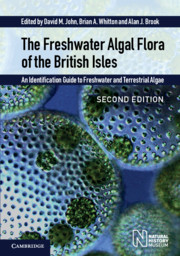 The Freshwater Algal Flora of the British Isles
The Freshwater Algal Flora of the British Isles Published online by Cambridge University Press: 12 January 2024
Freshwater algae have been a subject of interest for naturalists and professional scientists in the British Isles for more than two centuries. As can be seen from the long reference list, many made observations over long periods and their records range from notes in natural history periodicals to long ecological accounts in learned journals. Nowadays an increasing number of people are required to name algae accurately, particularly those involved in managing and monitoring the water environment. All this suggests the need for readily available modern books, that are straightforward to use, on how to identify freshwater algae in the British Isles, Europe and worldwide. However, such books do not exist, and the present Flora sets out to fulfil this need for freshwater and terrestrial algae other than diatoms.
Before explaining the scope of the Flora, it is worth giving a little background. Following the ‘Earth Summit’ held in Rio de Janeiro in June 1992, various international and national strategies were prepared for the conservation and sustainable use of biological diversity. The oceanic planktonic algae have received some attention because of their importance in global processes, but freshwater algae were mostly included simply as estimates of numbers. The UK Biodiversity Steering Group Report (Biodiversity, 1995a) estimated there to be 20 000 algal species in the UK, about 650 of which are seaweeds. However, a checklist of the freshwater and terrestrial algae of Great Britain and the Republic of Ireland (Whitton et al., 1998a) reported only about 5000 species. Other sources of information and new discoveries are in the second edition of A Coded List of Freshwater Algae of the British Isles (Whitton et al., 2003). However, many more detailed field surveys are needed to provide a more reliable estimate of species diversity. Of those species that are known, it is possible to comment reliably on the overall status of only a hundred or so in the phyla covered here. In addition to the commonest species, a few others are sufficiently distinctive to make a sound assessment of their general distribution. The red alga Thorea hispida, the water-net Hydrodictyon reticulatum and some charophytes (stoneworts) are examples.
The situation is of course dynamic with losses and gains due to natural changes or human activity.
To save this book to your Kindle, first ensure [email protected] is added to your Approved Personal Document E-mail List under your Personal Document Settings on the Manage Your Content and Devices page of your Amazon account. Then enter the ‘name’ part of your Kindle email address below. Find out more about saving to your Kindle.
Note you can select to save to either the @free.kindle.com or @kindle.com variations. ‘@free.kindle.com’ emails are free but can only be saved to your device when it is connected to wi-fi. ‘@kindle.com’ emails can be delivered even when you are not connected to wi-fi, but note that service fees apply.
Find out more about the Kindle Personal Document Service.
To save content items to your account, please confirm that you agree to abide by our usage policies. If this is the first time you use this feature, you will be asked to authorise Cambridge Core to connect with your account. Find out more about saving content to Dropbox.
To save content items to your account, please confirm that you agree to abide by our usage policies. If this is the first time you use this feature, you will be asked to authorise Cambridge Core to connect with your account. Find out more about saving content to Google Drive.